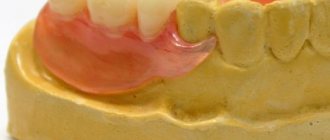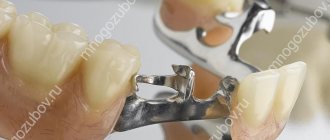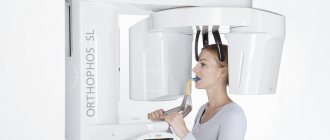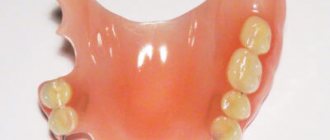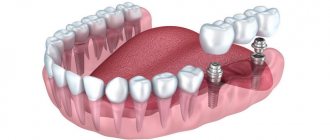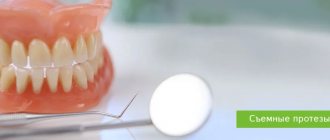Clasp prosthesis with locks
- one of the varieties of partial clasp removable structures, which is fixed on the supporting teeth with the help of locks.
This option is considered one of the most advanced designs. Clasp dentures with locks consist of a metal frame in the form of an arc. The frame is a plastic base with artificial teeth with fastenings-locks. One fastening element of the prosthesis is located on the supporting tooth under a metal-ceramic crown, and the second is located directly on the clasp prosthesis. This type of prosthesis has another name - clasp prosthesis with attachments
(from the English word “attachment”, which is translated as “fixation”, “attachment”).
Consultation with an orthopedic dentist—RUB 1,000.
Double-sided clasp prosthesis with locks - RUB 71,000.
Double-sided clasp prosthesis using Bredent locks - RUB 50,000.
Friction pin - RUB 9,200.
At CELT you can get advice from a dental specialist.
- The cost of an orthopedic consultation is 1,000
Make an appointment
Indications
The main indication for the use of clasp dentures with locks on the upper or lower jaw
is the impossibility of installing implants. It is also important to have supporting teeth on which they can be securely fixed. As for other indications, they are as follows:
- terminal defect of the dentition on one or both sides;
- a large extent of the dentition defect, i.e. the absence of several teeth in a row.
Contraindications
- the frenulum of the tongue is not long enough;
- deep bite;
- pathological conditions of the oral cavity in the acute stage;
- diabetes;
- individual metal intolerance;
- lack of supporting teeth;
- pathologies of oncological nature;
- insufficiently deep floor of the oral cavity.
Features of locking
Clasp dentures with locks can be used on the upper and lower jaws, thanks to their reliable fixation. Clasp dentures with attachments, photos of which you can see on our website, have supporting parts that are located on the inside of the oral cavity. They are ideal for use with the last teeth extracted and with extracted teeth limited to other teeth. The locking mechanism consists of two parts: the first (matrix) is integrated into the crown or other non-removable structure, and the second (matrix) is connected to the base of the prosthesis. It is worth noting that, unlike the clasp variety of yoke dentures, locking analogues eliminate the transfer of intense loads to the supporting tooth. The only drawback is the higher cost of clasp dentures with locks
. Prices are determined by the labor intensity and complexity of their production. However, clasp dentures with locks, the prices of which are slightly higher than clasp dentures, will “work out” every ruble invested in them. They are very convenient and easy to use, do not affect diction, and do not cause discomfort when eating.
Types and advantages of clasp dentures
In modern dentistry, prostheses are widely used, the distinctive feature of which is the presence of micro-locking fasteners, clasps, with a telescopic fixation mechanism.
The clasp design is a solid cast arch with a base (plastic base) and artificial teeth located on it.
This prosthetics is used in situations where, for a number of reasons, it is not possible to install implants.
The advantages of using these models are:
- ease of use, thanks to a thin arc, reliable fixation, the adaptation process is much faster; it does not change speech, does not reset, and allows you to completely restore chewing functions;
- durability is achieved due to the small, especially in comparison with other types of removable dentures, load on the gums and bone tissue, which slows down the atrophy process and allows you to wear the system for a longer period of time without changing the denture;
- dentures can be removed only for hygienic care, leaving them on overnight;
- strength, which is associated with the use of a solid cast arc, which minimizes the risk of system failure;
- aesthetic appearance, especially in terms of the ability to restore the aesthetics of teeth when choosing dentures with locking fastenings, or those that are fixed using telescopic crowns;
- splinting dentures allow you to combine dental restoration with the treatment of periodontal disease.
As you can see, there are enough advantages, but one cannot fail to mention the existing disadvantages:
- high price;
- decrease in elasticity when fastening with clasps;
- The complete absence of teeth does not allow the installation of structures; there must be at least four supporting teeth.
There are also certain indications and prohibitions for installing such systems, which experts will tell you about in relation to each specific case.
Clasp lock device
Fixation with micro-locks has its own characteristics. Thus, half of the element is located directly on the orthopedic structure, and the second is on the supporting teeth, hidden under metal-ceramic crowns. Reliable fixation of the prosthesis is carried out by clicking the lock and prevents it from moving or falling out. The type of micro-lock plays an important role in this case. According to reviews of clasp dentures with doctors’ locks, the best types of locks are “MK-1” and “Bredent”, made in Germany. "MK-1" is a bolt-type lock, but the clasp prosthesis is based on "Bredent" locks
has a friction type attachment. It is very important that not only the prosthesis itself is of high quality, but also that its lock is reliable and durable.
Clasp clasp dentures
Dental prosthetics does not lose its relevance. By choosing clasp clasp dentures, the patient regains the ability to chew food normally; they are practically indistinguishable from real teeth, which improves the overall aesthetics.
The design of the clasps consists of hooks through which the prosthesis is secured in the patient’s mouth. To make clasps, metal alloys are used, and the structure itself is used both for fixation and for performing support functions.
Types of clasp clasps
Along with fixing dentures, clasps help distribute the load on the gums and supporting teeth. Metal hooks are attached without preliminary turning, directly at the dental neck.
The design of the clasp consists of three elements:
- 1. Arcs.
- 2. The base on which the artificial teeth are located.
- 3.Fixing clasps.
There are several options for making clasp fastenings:
- sagging of the retaining clasps when chewing food; as a result, the load is transferred to the gums and oral tissues;
- Support clasps are characterized by a redistribution of the load on their teeth, which are used as support teeth; the load is partially distributed over the soft tissues of the oral cavity;
- The most popular are support-retaining clasps; the hook in its fixed part is located in the upper part of the tooth; clasp shoulders are placed on the front and back sides of each of the supporting teeth; the presence of a special lining prevents the formation of excessive pressure from the clasp on the mucous membrane; the process is that part of the clasp that is connected to the base.
There are differences between clasps, according to their design, based on:
- shapes – round, flat, ribbon;
- fixation method - with one and two arms, made in the form of a ring;
- production technologies – cast, bent.
A clasp is a metal strip that tightly covers the tooth at its widest point. It becomes desirable to cover the supporting teeth under the clasp denture with artificial crowns of a solid cast or metal-ceramic type.
The fixing and supporting functions of the clasp help distribute the chewing load between the teeth and the mucous membrane itself. The ideal option for this distribution is 1:3.
The disadvantages of this type of design include low levels of external aesthetics, especially since you can see the metal parts of the clasp when a person smiles or talks.
Moreover, the risk of breakage of the solid-cast structure made together with the arc is minimal.
What to give preference to?
When it comes to choosing the most suitable design, it is worth considering in detail the following options:
- 1. Cast clasp prosthesis, which practically does not spring during use.
- 2. Bent, the production of which involves the use of special blanks. This type is one of the most reliable products. Removing and putting them on repeatedly does not affect the basic characteristics. Flexibility and springy properties allow them to be perfectly adapted to any characteristics of the mouth.
In case of high-quality selection of a suitable model, the prosthesis is almost invisible.
Among the disadvantages of bent clasps, it is worth noting that the service life completely depends on the quality of fixation of the hook underlying the prosthesis. Also, they cannot be installed when the angle of inclination of the main teeth is too large.
Where to make?
If you want to be sure of the quality of the clasp prosthesis (Moscow)
and its installation, as well as the fact that they will select for you exactly the option that will best suit your individual characteristics, contact the orthopedic dentistry of our CELT clinic. The quality of our designs allows:
- distribute the chewing load evenly;
- prevent loosening of teeth;
- guarantee a high level of aesthetics;
- provide physiological load on the tooth;
- prevent damage to enamel and gum tissue when removing/installing a prosthesis.
Clasp denture with locks, clasps or crowns
Any dentist will say that the best prosthesis is an implant, but at the same time, such prosthetics are still the most expensive, and therefore not every patient can agree to it. And not only for financial reasons one has to refuse implantation, but also because there may be contraindications to such an operation. A clasp prosthesis may be a worthy alternative in this case, unless it causes allergies. Of course, this design also has its drawbacks, but the main advantage is the relatively low cost, compared to implants, and the less time-consuming process of prosthetics as such. So, let’s find out what is good about a clasp prosthesis.
Advantages:
- Excellent aesthetic characteristics (metal elements are hidden under the crowns);
- Maximum reliable fixation of the orthopedic structure;
- The ability to chew food thoroughly without experiencing pain;
- Long period of operation - about seven years;
- Quick adaptation due to the small volume of the prosthesis, eliminating diction disorders;
- High repairability of the structure;
- The rigidity of the metal that underlies the structure determines the uniform distribution of the load throughout the entire dentition, which makes it possible to stop gum atrophy.
Which prosthesis is better, clasp or nylon?
Both types of prostheses deserve attention, but the nylon design is considered more modern. This is due to a number of factors: lightness, comfortable adaptation in the mouth and easy wearing, no problems with rubbing soft tissues in individual nodes.
And caring for nylon is easier than with the metal version. Although the chewing load is better distributed by a clasp type product.
If we consider the main advantageous characteristics of nylon prostheses, they outweigh their metal counterparts in the following indicators:
- hypoallergenic;
- flexibility, elasticity;
- low probability of breakdown;
- The transparency of the material increases aesthetics.
There are also not many disadvantages to nylon prostheses, but they are significant. For example, it is no longer possible to repair a broken product. And the price of new ones is steep.
What is the price?
The cost of a clasp denture with locks depends on which clinic you go to. If you want to be sure of the quality of the design, you should not save. Approximate prices for Moscow are as follows:
- One-sided clasp design - from 40 thousand rubles;
- Clasp prosthesis with reliable “Bredent” locks - from 40 thousand rubles;
- Clasp prosthesis with reliable locks “MK-1” - from 50 thousand rubles.
You can find out the prices of clasp dentures at the CELT clinic in this section or by calling us and making an appointment for a consultation.
Splinting clasp dentures
If a patient is diagnosed with periodontal disease, doctors can offer him a splinting design to choose from. Its use helps reduce tooth mobility, helps restore chewing functions and attractive appearance. A distinctive feature of this design is an additional arch, which is placed on the inside of the prosthesis.
A splinting clasp is a removable structure used if the patient has mobility of the dentition (individual teeth).
The main purpose of clasp dentures with splinting elements:
- tending loose teeth;
- restoration of lost ones.
The design of a splinting clasp prosthesis is a metal arch containing clasps of many links, claw-shaped processes, rings that fix each of the moving teeth.
For the supporting teeth, on which the entire structure is attached, crowns are provided, which helps to evenly distribute the additional load when chewing food from those teeth that are loose to healthy and alveolar processes.
How effective the procedure for strengthening teeth will be depends on what stage the disease is at.
The splinting clasp design is determined individually for each patient. Much depends on factors such as age, type of bite, condition of mobile teeth, as well as the number of lost ones.
Indications for the use of clasp splinting prosthetics are:
- if at least three teeth are missing in the dentition and there is no support on one side;
- the presence of diseases of the tissues that surround the teeth, with bleeding gums;
- teeth are in the wrong position;
- bruxism and deep bite;
- defects in the dentition that caused tooth displacement;
- roots are exposed;
- Gum pockets are clearly visible.
How to care?
Orthopedic structures require proper care. This is the only way they will provide their owners with maximum comfort and serve for a long time. Caring for them includes the following:
- Rinse the denture with clean boiled water after each meal;
- Regular cleaning at home using special solutions and brushes;
- Professional cleaning in dentistry.
Clasp prosthetics at the CELT clinic are performed by specialists with extensive experience. They have modern equipment and high-quality materials in their arsenal, which is the key to the success of the treatment. At the same time, we try to keep prices affordable and cooperate with modern, proven dental laboratories. Contact us!
Make an appointment through the application or by calling +7 +7 We work every day:
- Monday—Friday: 8.00—20.00
- Saturday: 8.00–18.00
- Sunday is a day off
The nearest metro and MCC stations to the clinic:
- Highway of Enthusiasts or Perovo
- Partisan
- Enthusiast Highway
Driving directions
Types of fastenings
All orthopedic prostheses in dentistry are divided into groups:
- removable;
- fixed;
- partially removable.
Clasp structures belong to the third group, since removal is carried out only to perform hygienic procedures. Patients easily cope with this task with one movement of the hand. There is no need to remove the denture at night.
When chewing food, emotional conversations and expressions of joy (laughter), there is no need to worry about the reliability of the fixation. The prosthesis is firmly held by fastenings.
Why should you entrust us with the manufacture and installation of clasp dentures?
High level of specialists.
Our products serve for at least 10 years, performing all the functions assigned to them, thanks to the correct choice of fastening type and competent calculation, which becomes possible only with many years of daily practice and constant improvement of skills and knowledge.
Teamwork.
Thanks to the coordinated actions of each of our doctors, dental technicians, administrators, and assistants, you receive a denture with locks on time and with a predictable result. We don't serve breakfast and keep our promises.
Impeccable workmanship
- jeweler precision of technical operations - modeling and casting of the frame, the use of digital technologies, as well as strict control at each stage help to achieve 100% aesthetics and full functionality.
Preparation according to all rules
– before installation, we must make sure that all pockets of caries have been eliminated, we carry out professional cleaning, and provide instructions for use and care. This way we preserve the remaining “natural” teeth and extend the service life of artificial ones.
Affordable price.
We have one of the most attractive ratios between price and quality in Moscow. In addition, we regularly hold promotions, offer installment plans, credit and tax deductions, and will find a way to reduce the price without compromising aesthetics, functionality, durability and timing.
Clasp dentures with locks are popular, aesthetically pleasing and affordable. Don't put off regaining your beauty and confidence.
Have you decided? Come for a free consultation. We'll take a look, answer questions, and dispel doubts.
Attachment option (lock fastening)
One of the parts of the micro-lock (attachment) is located on the teeth enclosed in metal-ceramic crowns, and the second is on the clasp prosthesis. The mechanism snaps into place and provides a secure fit.
According to the method of fastening, locks are divided into the following types:
- intra-root, which are held on root caps;
- placed inside the product;
- soldered to the surface of the implant.
Before installing the prosthesis, the specialist cleans the enamel using ultrasound. It is important to cure all pathological phenomena in the oral cavity. A mandatory step is the installation of at least four crowns on the treated and ground abutment teeth. After completing the procedures, the structure is placed on the surface of the jaw.
Lock fastenings have a number of advantages - they are practically invisible, comfortable, and last 5-7 years or more. The design is considered high-tech and requires highly qualified specialists, but is not visible to others.
There are several types of attachments:
- hinged - joint;
- labile - shifting in any plane;
- crossbar - having a small valve;
- anchor - linked by a sphere or a button;
- semi-labile - capable of moving vertically;
- beams - a thin rod between the crowns that fits into the groove on the bottom of the prosthesis.
The choice of prosthesis is made by an orthopedist, focusing on the needs of the patient. The main mechanical impact in a design with a rigid connection is transmitted to the abutment teeth taken under the crowns. In a softer version, the load is evenly distributed over the entire jaw.
According to the level of rigidity, attachments are divided into three types:
- the toughest ones are red;
- medium hard - yellow;
- soft - green.
The locking mechanism quickly weakens, and the locking elements may need to be replaced every year and a half. The cost of repairs is about 100 rubles. The orthopedist removes worn parts and immediately installs new ones.



